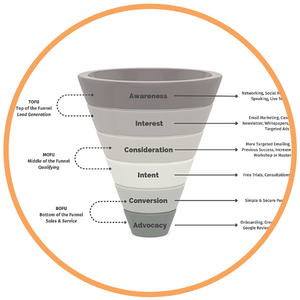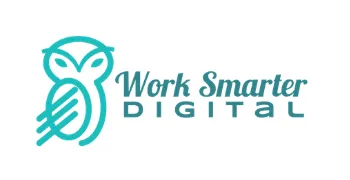
How a Marketing and Sales Funnel Works to Get More Clients
Funnels, funnels, funnels. There is so much noise about funnels and not a lot of straight talk about what they are and how to use them in your business. I work with service-based businesses like coaches, consultants, attorneys and creative agencies and they ask me the same questions:
- Do I need a funnel?
- Do I need a sales or marketing funnel?
- Do I need to have a funnel for each of my services?
Yes, you need a funnel that moves from marketing to sales and you likely only need one funnel. For service-based businesses, we are focused on one-to-one relationship building and a lot of the “funnels” chatter is really directed at products, ecommerce, or commodity type businesses. What sells a new planner is not going to work for a $5k coaching package.
Let’s explore what a funnel is, how it works, and what will work best for your service-based business.
What is a Funnel?
The funnel is a nice and neat visual representation of your customer journey. The shape of the funnel also represents the amount of people at each stage in your customer journey. At the top of the funnel, you want to attract lots and lots of people. As they move through the funnel, the number of people that are interested in your services and ready for your services gets smaller and smaller. That’s what we want. We want our funnel or customer journey to qualify future customers, so we are left with our most ideal customer.
“[The sales and marketing funnel] is a consumer-focused marketing model that illustrates the theoretical customer journey toward the purchase of a good or service.” ~Wikipedia
A complete funnel represents both marketing and sales from when a contact first learned of your business to when they finish working with your business. The funnel is a framework for defining your customer journey and ensuring each step interlocks with the next step. The goal is to build trust as a person moves through the funnel and readiness for your services.
Does a Funnel Need to be Complicated to Convert?
The answer is no. A funnel can and really should be simple. As service-based businesses, we don’t need the 37 step funnel with multiple upsells and countdowns. We need a funnel that allows us to build the know-like-trust factor with integrity and fosters a relationship that converts to a client.
Funnel Example
This is a really basic funnel and one that many of my service-based clients follow. Service-based businesses are generally based on one-to-one relationships, so this funnel starts with networking as the top of the funnel awareness activity.
- Attend networking events to meet new people
- Follow-up and schedule one-to-one meetings
- Invite them to join your community
- Share a quick-win resource and add them to your mailing list
- Invite them to a deeper dive workshop or masterclass to learn more about what problem you solve and how you solve it
- Make an offer to work with you and schedule a discovery call
- They sign up and pay for your offer
- Deliver your rock star services and exceed their expectations
- Request a Google Review
This is the best-case scenario, but an example of how a well thought out funnel can work for your business.
Phases of the Marketing and Sales Funnel
There are several variations on the marketing and sales funnel, but they all follow the same methodology. I prefer the funnel that has six stages including: Awareness, Interest, Consideration, Intent, Conversion, and Advocacy. I’ve grouped these six stages by where they are in the funnel, which is most commonly referred to as TOFU, MOFU, and BOFU.

Top of the Funnel (TOFU) - Lead Generation
1. Awareness
In this stage, you are creating awareness of your brand and problem you solve. You may also be helping people recognize they have a problem. You are positioning yourself as an expert with a unique perspective.
The types of marketing activities to generate awareness are SEO, Social Media, Advertising, Speaking, Live Streams, and Networking.
2. Interest
In the Interest stage, you are providing value-added content that is answering deeper questions about the problem you solve and solution you provide. The intent is to educate and help them build a deeper understanding of how to solve their problem.
The types of marketing activities to assist in this information searching phase are Email Marketing, Case Studies, Newsletter, Whitepapers, Workshops, and Targeted Ads.
Middle of the Funnel (MOFU) - Qualifying
3. Consideration
In the consideration stage, you are developing a desire to own or have the service. The contact has decided they need a solution and they are shopping around. Your content should help them decide that your solution is the right one for them.
The types of marketing activities to assist in the evaluation phase are More Targeted Emailing, Highlight Previous Success, Increase Credibility, and Workshop or Masterclass.
4. Intent
In the intent stage, the contact is ALMOST a client and they have indicated they are interested in making a purchase. This is when you take off your marketer hat and put on your sales hat.
The types of sales activities to assist in the intent and commitment phase are Free Trials, Consultations, and Sales Calls.
Bottom of the Funnel (BOFU) - Sales & Service
5. Conversion
In the conversion stage, congratulations you’ve got a new client. The main job in this stage is to have them sign on the dotted line and make their payment.
The types of sales activities to assist in the purchase phase is a Simple & Secure Purchase Process.
6. Advocacy
In the advocacy stage, you are delivering your service and exceeding your clients expectations. The most important transition is from prospect to buyer, so you want to ensure they get a lot of reinforcement with a great client onboarding series that they made the right investment.
The types of activities to assist in the loyalty and advocacy phase are Client Onboarding, Great Service & Outcomes, and Google Reviews & Recommendations.
Digital Marketing Tools Needed for a Funnel
You do not need the most expensive tools on the market, but you will need tools to seamlessly guide your contact through the journey. You must include automation and integration in your digital marketing tools. Without these, you will be doing a lot of data entry between tools and likely create a very leaky lead funnel.
- Social Media - Used to create awareness of your brand, social proof of who you are and what you do, as well as build the know-like-trust factor.
- Optin Landing Pages - Used to collect contact information and convert social followers to contacts as well as track interest in your services.
- Online Appointment Scheduling - Relationship building means one-on-one meetings and the most efficient way to do that is with an online appointment scheduler. It is also an efficient way to collect contact information.
- Email Marketing - Think of email marketing as your communication hub and not just as a marketing tool. This is how you automate communications to your contacts and clients throughout their journey.
These are the foundational tools you need. Depending on your business, there may be more features you need. My recommendation is to always go for an all-in-one CRM solution over one off tools. An all-in-one CRM solution will have all the features you need, plus integration and automation are built in. The Work Smarter CRM is a great solution for service-based businesses like coaches, consultants, attorneys, and agencies.
Build The Only Funnel You Need
Now that you have a better understanding of a marketing and sales funnel, let’s talk about how to create yours. As I’ve said, your funnel should align with how you already work and is focused on relationship building.
What you need to get started is clarity of your marketing message and value proposition, knowing your ideal client, understanding your ideal client's decision process, and willingness to experiment. Imperfect action in building your marketing and sales funnel is far better than never starting. Remember, this is how new contacts will experience your business. Put yourself in their shoes and think about what information you would want at each stage and how you’d like to feel. You can do this!
These are a few of my best practices when developing a marketing and sales funnel.
- Keep it simple! Don’t over complicate it.
- Avoid the gimmicky quick money maker funnel models.
- Get clear on your lead generation activities and ensure your systems support this from top of the funnel to the bottom of the funnel.
- Don’t add another funnel until your main money making funnel works. I’ve seen too many people add a totally online digital product to the mix that requires a separate funnel.
- You will have multiple top of the funnel activities like social media, networking and speaking. Make sure each has the proper awareness and interest stage activities to support them.
- Your middle and bottom of the funnel activities should be the same for all of your service offerings with some content differences. The process should be the same.
- Use an all-in-one CRM solution to build your automation. The more tools. The more complex.
Most importantly, you should focus on content development for your marketing and sales funnel. No one can develop or direct the development of your content, but you. Without content, the funnel doesn’t function. Building automations, designing emails, and creating landing pages is incredibly time consuming and requires its own expertise. Don’t spend your time here. I’ve seen lots of clients get stuck in implementation and delay taking action. Get the support you need to build out systems and start getting results.
In Summary
Yes, you need a marketing and sales funnel. No, it doesn’t need to be overly complicated. Your funnel does need to connect the dots from one stage to the next. You can create your marketing and sales funnel with the right solution and support. We at Work Smarter Digital can help you with that. We have the all-in-one solution and implementation services you need to get this done, so you can convert more clients. We focus on ensuring you implement your funnel, so you start reaping the benefits as quickly as possible.
The Funnel Self-Assessment walks you through collecting the right data to determine how well your funnel is working for you.
Mary Sue Dahill, Founder & CEO of Work Smarter Digital
Ambitious business owners that are tired of marketing gimmicks and digital tools that don't work work with Mary Sue. Because they want one solution that removes complexity and gets their business out of neutral, so they can stop scrambling for their next client and start enjoying the freedoms of entrepreneurship.
Before you buy another digital tool, ask me first! Schedule a Digital Success Strategy Call to explore what’s possible.

INTENTIONAL CUSTOMER EXPERIENCE AUTOMATION
OMNI-CHANNEL MARKETING
© Copyright 2020. Work Smarter Digital - powered by Work Smarter CRM
